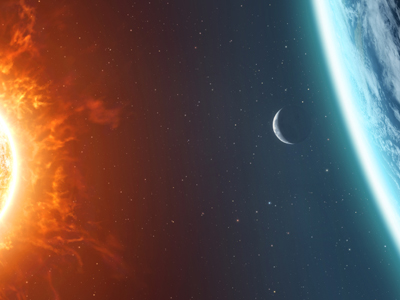
Ask the AI Tutor
Need help with The Solar System? Ask our AI Tutor!
AI Tutor - Lucy
Connecting with Tutor...
Please wait while we establish connection

The path a planet follows around the Sun is called an orbit.
The Solar System
Our Solar System is home to eight planets, the Sun, moons, and many smaller objects. In KS2 Science, pupils explore these fascinating worlds and their unique features.
1 .
Life is found on which of these planets?
Earth
Earth and Mars
Neptune, Venus and Earth
Jupiter and Earth
No life has been found on any planet apart from Earth - at least, not yet!
2 .
What is the Sun?
A comet
A star
A planet
An asteroid
The Sun is our nearest star - it's only 148 million km away!
3 .
How long does it take the Earth to orbit the Sun?
24 hours
52 weeks
365 days
Two years
It actually takes the Earth just over 365.25 days to orbit the Sun, which is why there is an extra day in a Leap Year, occuring every four years
4 .
Measured by diameter, how much bigger is the Sun than the Earth?
Approximately twice as big
Approximately 10 times
Approximately 100 times
Approximately 1,000 times
The Sun's diameter is 1,377,648 km while the Earth's is 12,756 km
5 .
What are Saturn's rings made of?
Light beams trapped by Saturn's gravitational pull
Ice particles
Thousands of moons
An asteroid belt
Saturn's seven rings are made of ice particles which travel in orbit around the planet
6 .
Which planet is closest to the Sun?
Mars
Venus
Earth
Mercury
Mercury is 46 million km from the Sun
7 .
Which is the largest planet in our Solar System?
Saturn
Neptune
Earth
Jupiter
The Earth could fit into Jupiter 1,000 times
8 .
What do we call the path a planet follows around the Sun?
An orbit
A circle
A gravitational pull
A rotation
An orbit is the path an object in space follows around another object - the Moon orbits the Earth, which orbits the Sun
9 .
Which of these is the correct order of the planets (including the dwarf planet)?
Mercury, Venus, Mars, Earth, Saturn, Jupiter, Uranus, Neptune, Pluto
Mercury, Venus, Earth, Mars, Jupiter, Saturn, Uranus, Neptune, Pluto
Mars, Venus, Earth, Mercury, Jupiter, Saturn, Uranus, Neptune, Pluto
Earth, Venus, Mercury, Mars, Jupiter, Saturn, Neptune, Pluto, Uranus
Here's a mnemonic to help you remember - My Very Educated Mother Just Served Us Nine Pizzas
10 .
How many planets are there in the solar system?
Seven
Eight
Nine
Ten
Eight for now! Pluto has been called a 'dwarf planet' since 2006, when scientists debated whether it was large enough to count as a true planet - the debate continues to this day
**Unlimited Quizzes Await You! 🚀**
Hey there, quiz champ! 🌟 You've already tackled today's free questions.
Ready for more?
Ready for more?
🔓 Unlock UNLIMITED Quizzes and challenge yourself every day. But that's
not all...
not all...
🔥 As a Subscriber you can join our thrilling "Daily Streak" against other
quizzers. Try to win a coveted spot on our Hall of Fame Page.
quizzers. Try to win a coveted spot on our Hall of Fame Page.
Don't miss out! Join us now and keep the fun rolling. 🎉
**Unlimited Quizzes Await You! 🚀**
Hey there, quiz champ! 🌟 You've already tackled today's free questions. Ready for more?
🔓 Unlock UNLIMITED Quizzes and challenge yourself every day. But that's not all...
🔥 As a Subscriber you can join our thrilling "Daily Streak" against other quizzers. Try to win a coveted spot on our Hall of Fame Page.
Don't miss out! Join us now and keep the fun rolling. 🎉






